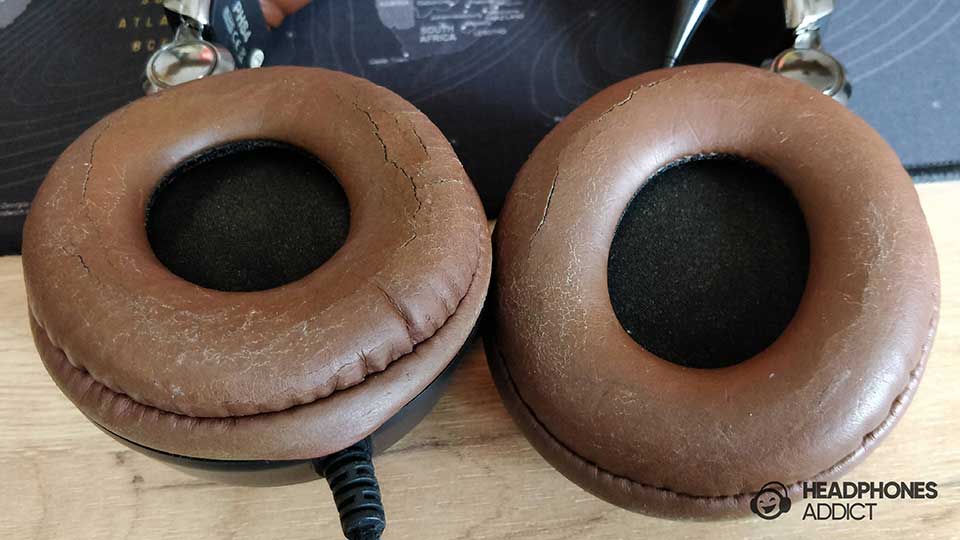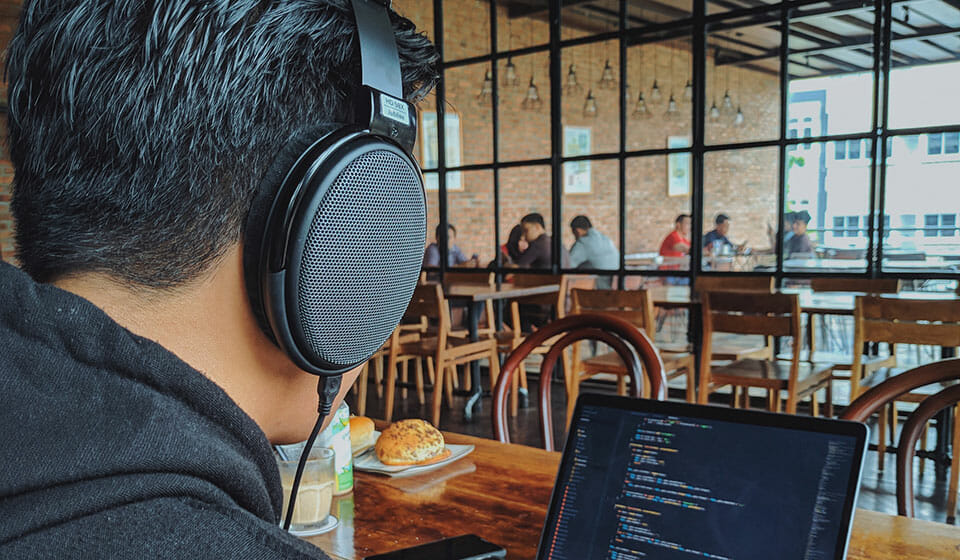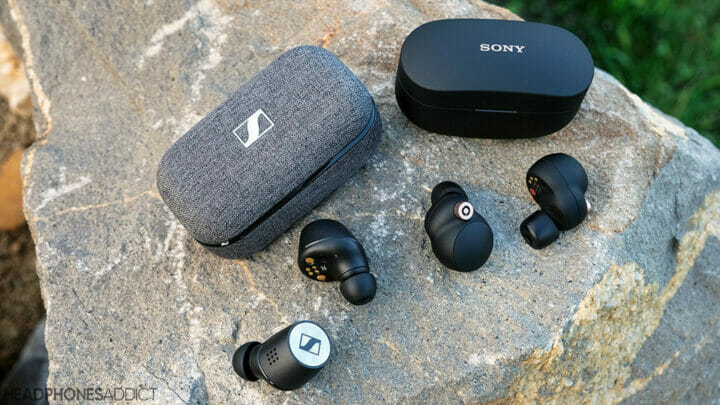You’ve probably heard it. The exact song a stranger listened to in public (that you weren’t interested in).
The bad news is that your headphones likely suffer from sound leakage, too. Here’s how to fix it.

It annoys most people.
Sound leakage—or music bleed is a problem with all headphones. Some more than others.
Check for solutions here.
What is Headphone Sound Leakage?
Sound leakage (or sound bleed) is the effect of music escaping from your headphones into the outside world. When others can hear your music, it bothers those who want silence and takes away from your sense of privacy.
It can get you in trouble in a library and office or make people stare at you when listening to something you don’t want others to know about.
It’s more audible at higher volumes (high sound pressure level) and largely depends on the type of headphones. Headphones with worse passive noise isolation leak more sound.
On the other hand, at low volume, it’s often impossible to hear.
All headphones “bleed” or leak some music to ambient environment.
No headphones have perfect noise isolation but in-ear headphones and earbuds usually leak the least.
Why do headphones leak sound?
Headphones leak sound because some of the air vibrations (sound) break through the ear cups and ear pads. The higher the volume, the more sound leakage occurs. It’s physically impossible to stop all sound with the amount of material in a standard pair of headphones.
While many modern headphones use thick, sound-absorbing materials to improve sound isolation, there’s always some audio leakage present.
So far, no headphone manufacturer managed to create headphones with no sound leakage.
Sound is basically air pressure that moves air particles which our ears can sense.
The higher the pressure, the more “break-through” power it has. So, higher volumes penetrate materials better resulting in sound leakage and potential noise-induced hearing loss.
The sound travels from the starting point and extends all around it until slowly diminishing with range.
You can revent it from spreading, with physical barriers like plastics, wood and sound-absorbing foam.
Nonetheless, if listening closely to a person wearing headphones some sound will always be audible.
Can you block all sound leakage?
To block sound to inaudible levels, you’d have to use an uncomfortable amount of material which would make headphones cumbersome and useless.
But there are some things you can try. See the steps below.
Why should you care about sound leakage in headphones?
Headphone sound leakage is annoying when you want privacy and don’t want other people to hear your music or videos you’re watching (it can be embarrassing). Also, if the sound can leak out, it can break in too. So, ambient noise can ruin your listening experience.
And if you’re wearing headphones at work, it’s even more important. Would you like everybody in the office to know what you’re listening to?
Probably not.
Sometimes we travel to the weird places of the internet just because we have nothing better to do. Imagine how embarrassing it would be.
Having a sense of privacy is important. Get headphones with low sound bleed and keep your music to yourself.
How to Test for Sound Leakage in Headphones?
- The best way to test for sound leakage in your headphones is to borrow your friend.
- Let him, or her wear the headphones (with a tight fit and correct ear tips if earphones).
- Then play the music and increase the volume.
- It’s best to test in a quiet room, and you’ll soon know when the headphones start to leak.
You probably don’t have the necessary equipment to measure sound bleed objectively, so it’s best to rely on your senses.
And when you’re testing, try different genres of music as some might leak more than others. Play with the volume and remember the leakage starting point.
After you get a good sense of where the critical point is you can swap the roles and let your friend tell you their opinion.
Here’s an example of the headphone sound leakage test:
How can you tell if your headphones are leaking sound?
Apart from the test with your friend we mentioned above, you can also record the leakage with a microphone.
- Set up the microphone to record (like a smartphone)
- Put on the headphones
- Play with volume
- Listen to the recording
Another way to tell if your headphones are leaking sound is to use another method to mimic sound isolation as if you were wearing them (for on-ear and over-ear headphones).
You can use your hands, other parts of the body, or objects.
While the results might not be as accurate, you’ll still be able to determine which headphones leak more sound.
How to Fix Sound Leakage in Headphones?
To reduce sound leakage in headphones, try the following:
- Change the ear pads on your headphones with real or faux leather earpads, which isolate better.
- Use memory-foam ear tips on your earbuds, which are much better at keeping the music in.
- Lower the volume (I know it’s an unpopular solution, but it works. Turn on ANC if you have it and keep the volume lower. This will also protect your hearing.)
- Look for cracks or openings in the earcups. If your headphones are damaged and leaking more sound than before, you’ll have to fix or replace them.
Apart from that, there isn’t much else you can do.
Turning the volume down or wearing ear muffs over earbuds isn’t practical.
Each pair of headphones comes with some leakage which you’ll have to accept.
If your ear pads are old and worn out, you can replace them but don’t expect massive change. Open-back headphones will always leak sound.

Soft, squishy, foam ear tips are the best for the job.
A lot of earbuds come with them in the package, and you can always buy them separately (but make sure to get the right size that fits on buds and your ear canal).
Look at the manufacturer’s size guide to learn what diameter you should get for your in-ear headphones.
Comply memory-foam tips are the most popular and known. Check them on Amazon.
When is sound leakage too severe to repair?
If your headphones suffer from structural damage that opened the cups/buds (you might’ve dropped them), then the only way to fix the leakage is to repair them. Which is often costly and isn’t economical. In this case, it’s best to get a new pair.
What Type of Headphones Leak the Most Sound?
Here’s a comparison of headphone types by sound leakage:
| Type | Feature | Sound leakage |
|---|---|---|
| Open-back | Back-design | High |
| Semi-open | Back-design | Mediocre-high |
| Closed-back | Back-design | Lower |
| On-hear | Design | Higher |
| Over-ear | Design | Lower |
| Bone conduction | Design | Higher |
| In-ear headphones | Design | The lowest |
- Open-back headphones have the worst leakage due to open-to-air design that doesn’t block any air vibration.
- Semi-open headphones are a close second, a bit better than fully open but still pass on a lot of music.
- Closed-back headphones leak the least.
- On-hear headphones generally leak more noise than over-ears because of a looser fit on the ears.
- Over-ear headphones are about average (mostly depends on earpads and size)
- Bone conduction headphones have high bleed due to different technology.
- In-ear headphones (or earbuds) leak the least, especially with memory-foam ear tips
Most headphones today are closed-back over-ears since this is what most users prefer.

Nonetheless, you can find great open-back headphones, especially for home use, where sound quality can be enjoyed in a peaceful environment.
How does sound leakage affect headphone performance
Headphones with high sound leakage (open-back, semi-open) have bigger and broader soundstage, which gives a better sense of spacious sound. This is why they’re preferred by many audiophiles but bleed the sound. On the other hand, low sound leakage headphones (closed-back) offer smaller soundstage but better privacy (keep the music to yourself).
Sound leakage is connected to noise isolation.
Passive noise isolation block sounds in and out.
Note, isolation is not the same as noise cancelling, click here to learn the difference.
Music escaping out is what’s also called sound leakage.
Heavy “bleed” is not preferred by anybody, but if it brings better audio quality, many are willing to accept it.
Because open headphones don’t block the music inside their ear cups, it sounds more natural and gives a better impression of coming from a different direction.
When listening to orchestra music, you can hear the instrument positions quite well. It gives a feeling of listening to the music at a concert hall (instead of your home living room).
On the other hand, closed headphones try to keep the air vibrations (sound) inside the ear cups, which alters what you hear in the end.
Also, it hurts soundstage and positional accuracy. Everything sounds like it’s originating in the middle of your head.
Where is Reducing Headphone Sound Leakage Important?
Reducing sound leakage is essential in places where peace is expected:
- Work offices
- Library
- Study rooms
- Co-working spaces
- Home office if working with other people
You should care about your privacy and you shouldn’t bother others with your music.

It’s crucial you pick headphones with low leakage for office because you don’t want to annoy your coworkers. It makes it difficult to concentrate. So, open-back headphones in the image above are not a good choice.
Imagine a coworker coming to the office with a pair of headphones. And then blasting loud music so everyone can hear it. It wouldn’t positively impact your concentration.
Background noise pollution in offices is generally not accepted.
The Best Headphones with Low Sound Leakage Right Now
What are the best headphones with low sound leakage you can get today?
We’ve covered the types of headphones before. And here are the current headphone models that don’t leak a lot of sound.
Check the buying guides below:
Reminder: What types of headphones to look for?
- Closed-back headphones have low bleed and high isolation (compared to open-back and semi-open)
- In-ear headphones and earbuds with ear tips have low sound leakage
Here’s a comparison of open-back vs. closed-back headphones.
When picking headphones for low sound leakage, get headphones with thick earpads or earbuds/in-ear headphones with memory-foam tips.
Do bone conduction headphones produce sound leakage?
Bone conduction produces noise leakage because sound vibrations travel through the bone and air. Some of the music is always transferred to the air, so others can hear it. Bone conduction headphones have higher than average bleed.

What are the best bone conduction headphones?
There’s quite a selection of bone-conducting headphones you can choose from.
But the best are made by Shokz (previously AfterShokz), a steady market leader in the category. See the top bone conduction headphones here.
These are popular headphones for running by many and offer optimal audio quality and durability.

Matija Ferjan is a seasoned audio enthusiast reviewing headphones since 2015. He has personally tested hundreds of headphones and earbuds. He’s an active member of the Headphone Audio community and a true nitpicker, always looking for the “best-value-for-money” headphones.




